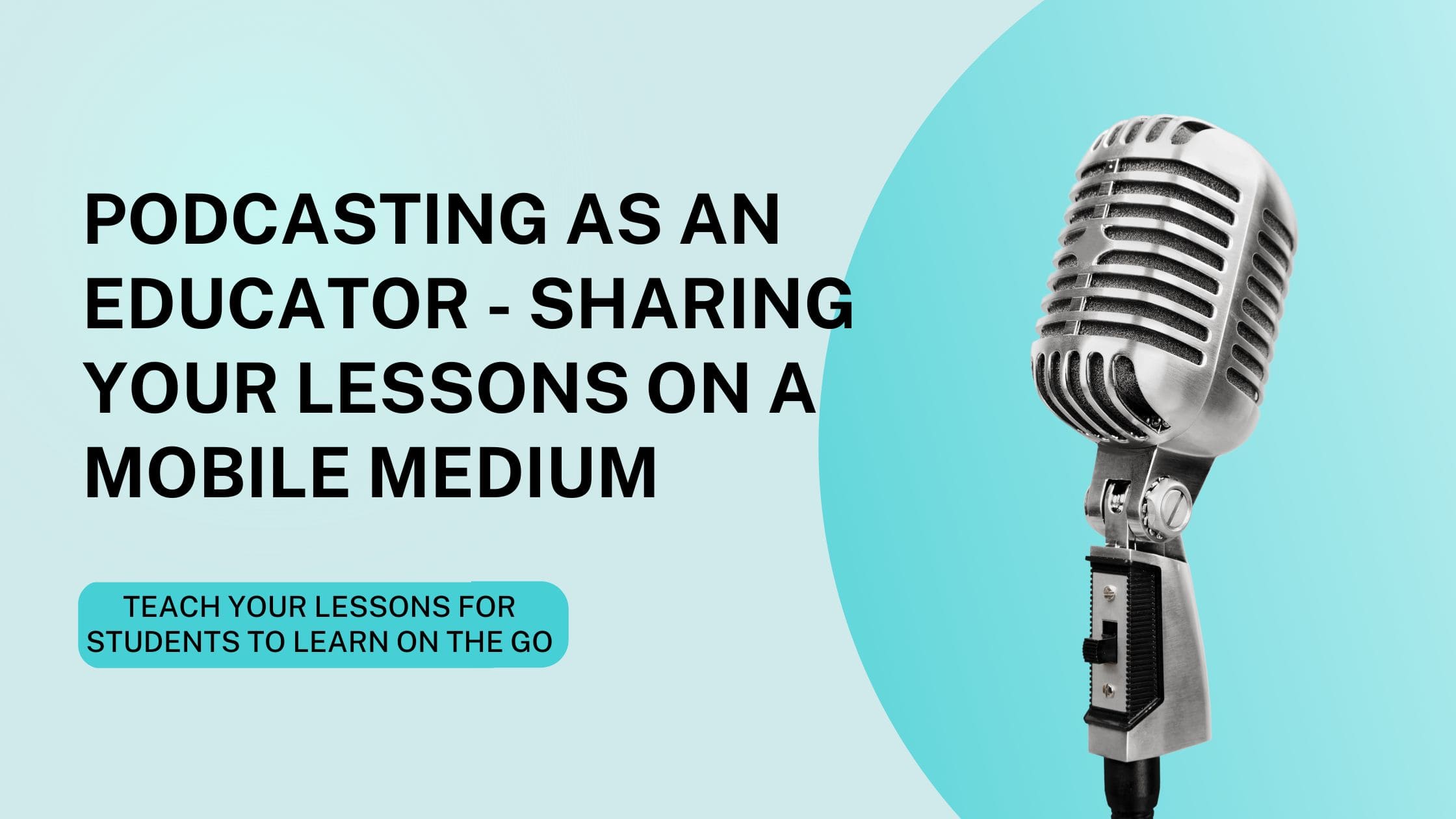Learn how to create educational podcasts and share your lessons on-the-go with our step-by-step guide. Enhance your teaching and engage your students today! This post does contain affiliate links. If you purchase any product/service through one of my affiliate links this website will receive a small commission at no additional cost to you. Thank you for your support!
Podcasting as an Educator – Sharing Your Lessons on a Mobile Medium
Hey there, podcasting pioneers and education enthusiasts! Have you ever found yourself itching to share your wealth of knowledge with the world but unsure of the perfect platform to make it happen? Well, look no further because we’re about to take you on an exhilarating journey into the wonderful world of podcasting as an educator.
In this step-by-step guide, we’ll unravel the mysteries of transforming your lessons into captivating audio experiences, right from the comfort of your mobile device. Get ready to embrace the power of your voice as we dive into the depths of this mobile medium, sprinkling it with our unique blend of wit, wisdom, and whimsy.
We know what you’re thinking – why podcasting? Sure, traditional teaching methods are tried and true, but if you’re itching to amplify your impact, reach a wider audience, and have the flexibility to impart knowledge anytime, anywhere, then podcasting might just be the game-changer you’ve been searching for.
So, grab your favorite pair of headphones, dust off that microphone (or find out which app will do the trick), and join us as we embark on an epic adventure, unraveling the secrets to podcasting as an educator. Prepare to educate, entertain, and enlighten your listeners, all while basking in the delightful freedom of the mobile medium. Let’s get started, shall we?
Why Should Educators Consider Podcasting? To Amplify Your Impact and Expand Your Reach
Isn’t it high time that you start sharing knowledge that extends beyond the four walls of your classroom? As an educator, it’s time to break free from the conventional teaching mold and embrace the limitless possibilities of podcasting. Here are some compelling reasons why professors and teachers should jump aboard the podcasting bandwagon:
1. Reaching a Global Audience: With podcasting, geographical boundaries become a thing of the past. Your voice can travel across the globe, connecting with learners from diverse backgrounds and cultures. Whether it’s students, professionals, or lifelong learners, your podcast has the power to educate, inspire, and engage a vast audience that extends far beyond your local community.
2. Flexibility and Convenience: As an educator, your schedule is often packed with lectures, grading, and administrative tasks. Podcasting offers you the freedom to share your lessons and insights on your own terms. Whether you’re commuting, taking a stroll, or enjoying a cup of coffee, you can record and release episodes at your convenience, providing your audience with valuable content they can consume on-the-go.
3. Enhanced Engagement and Active Learning: Traditional teaching methods sometimes struggle to capture students’ attention. Podcasting provides a dynamic and immersive learning experience, engaging listeners through the power of storytelling, interviews, and interactive discussions. By incorporating diverse voices and perspectives, you can foster critical thinking and encourage active participation among your audience.
4. Building a Personal Brand: Podcasting allows you to establish yourself as a thought leader and subject matter expert in your field. By consistently delivering valuable content and insights, you can build credibility and gain recognition within your educational community and beyond. A podcast serves as a powerful platform to showcase your expertise, connect with fellow educators, and collaborate on exciting projects.
5. Supplementing Classroom Learning: Your podcast can act as a valuable supplement to traditional classroom instruction. It provides an opportunity to dive deeper into complex topics, share additional resources, and reinforce key concepts covered in your lectures. Students can revisit episodes at their own pace, reinforcing their understanding and gaining a deeper grasp of the subject matter.
6. Fostering a Sense of Community: Podcasting is not a one-way street; it fosters a sense of community among your listeners. By encouraging feedback, questions, and discussions, you create an interactive space where learners can engage with you and each other. This sense of belonging and connection can enhance the learning experience, promote collaboration, and nurture a supportive educational community.
So, dear educators, it’s time to harness the power of podcasting and unleash your unique teaching style to a global audience. Embrace the freedom, flexibility, and boundless potential that this medium offers, and watch as your impact as an educator transcends the confines of the traditional classroom. Get ready to educate, entertain, and inspire the world—one episode at a time!
Planning Your Educational Podcast
Before you hit the record button and embark on your podcasting journey, it’s crucial to lay a solid foundation through careful planning. In this section, we’ll guide you through the essential steps to ensure your educational podcast is a well-structured and engaging experience for your audience. Let’s do this!
Defining your audience
Understanding your target audience is paramount to creating content that resonates. Consider who your ideal listeners are—students, professionals, or enthusiasts in your field—and delve into their needs, interests, and pain points. By gaining insights into their aspirations and challenges, you can tailor your content to provide maximum value and cater to their specific educational requirements.
Setting podcast goals
Take a moment to reflect on the goals you wish to achieve with your podcast. Are you aiming to supplement your classroom teaching, provide expert insights, or spark meaningful discussions? Establishing clear goals will not only guide your content creation but also help you measure your podcast’s success and make necessary adjustments along the way.
Choosing a podcast format
The podcast format you choose can greatly influence the tone, style, and structure of your episodes. Here are a few popular formats to consider:
a. Solo Monologue: In this format, you fly solo, sharing your expertise, insights, and experiences directly with your audience. It’s a great way to provide focused educational content and establish yourself as a trusted authority.
b. Interview-Based: Conducting interviews with experts, fellow educators, or individuals relevant to your field brings diverse perspectives to your podcast. It fosters engaging conversations, provides fresh insights, and offers your listeners a chance to hear different viewpoints.
c. Panel Discussion: Panel discussions involve multiple participants engaging in lively conversations on specific topics. This format encourages dynamic exchanges, debate, and collaborative learning. It can be a fantastic way to create an interactive and engaging experience for your audience.
Outlining podcast episodes
To ensure a coherent and organized flow for your podcast, it’s essential to create a detailed outline for each episode. Consider the following elements:
a. Introduction: Start with a captivating introduction that sets the tone and gives your listeners a preview of what to expect. Hook them in with an intriguing question, an interesting anecdote, or a thought-provoking statement.
b. Key Topics and Structure: Identify the key topics or concepts you want to cover in the episode. Break them down into segments or sections to maintain clarity and facilitate understanding. Consider the logical flow of information and make sure each segment transitions smoothly into the next.
c. Engaging Content: Plan your content to strike a balance between educational value and entertainment. Incorporate relevant examples, stories, case studies, or practical exercises to make your lessons more engaging and relatable. Visualize how you will explain complex concepts or theories in an audio-only format and consider using descriptive language to paint a vivid mental picture for your listeners.
d. Call to Action: Conclude each episode with a clear call to action, encouraging your listeners to engage further, share feedback, explore additional resources, or participate in discussions. This helps foster a sense of community and keeps your audience connected and motivated.
By carefully planning your podcast episodes, you ensure a structured and coherent learning experience for your audience. With each episode, you’ll provide valuable educational content that aligns with your goals and resonates with your target audience, setting the stage for an impactful and successful podcasting journey.
Recording Your Educational Podcast
Now that you’ve laid the groundwork for your educational podcast, it’s time to bring your voice to life and capture the essence of your teaching expertise. In this section, we’ll explore the essential steps for recording your podcast, ensuring crystal-clear audio quality, and adding that final polish to your episodes.
Choosing equipment and software
While you don’t need fancy equipment to start a podcast, investing in a few key items can significantly enhance the audio quality of your episodes. Consider the following:
a. Microphone: A good-quality microphone is essential for capturing clear and professional-sounding audio. USB microphones, such as the Audio-Technica ATR2100x-USB or the Blue Yeti, offer a balance between affordability and performance. If you prefer a more portable setup, lavalier microphones like the Rode SmartLav+ can be a convenient option.
b. Headphones: Invest in a pair of closed-back headphones to monitor your audio while recording and editing. This helps identify any background noise, distortion, or other issues that may affect the overall quality of your recordings.
c. Recording Software: Choose a recording software that suits your needs. Audacity and GarageBand are popular options for beginners, while Adobe Audition and Reaper provide more advanced editing capabilities. These software tools allow you to record, edit, and mix your podcast episodes with ease.
Tips for recording clear audio
a. Find a Quiet Space: Select a quiet location with minimal background noise to ensure clean audio recordings. Choose a room with good acoustics and minimal echo. Consider using soundproofing materials, such as foam panels or blankets, to reduce ambient noise and echoes.
b. Microphone Technique: Position the microphone at an appropriate distance from your mouth, typically 6 to 8 inches, to achieve clear and consistent audio. Avoid excessive plosives (popping sounds) by using a pop filter or positioning the microphone slightly off-axis from your mouth.
c. Test and Monitor: Before starting the actual recording, conduct a test to check the audio levels and ensure everything is functioning properly. Monitor your audio using headphones to catch any potential issues in real-time.
d. Speak Clearly and Modulate Your Voice: Enunciate your words clearly and maintain a consistent speaking volume throughout your recordings. Modulate your voice to keep your listeners engaged and attentive. Varying your tone and inflection adds depth and interest to your delivery.
Editing and polishing your podcast
a. Remove Background Noise: Use noise reduction tools in your editing software to minimize any unwanted background noise, such as fan sounds or room echoes. This helps create a clean and professional audio experience.
b. Trim and Arrange: Trim any mistakes, pauses, or unwanted sections from your recordings. Rearrange segments as necessary to ensure a smooth flow and logical progression of ideas. Maintain a balance between concise episodes and allowing enough time for in-depth discussions.
c. Add Intro and Outro Music: Include a catchy and relevant intro and outro music to create a cohesive brand identity for your podcast. You can find royalty-free music online or create your own custom jingle using tools like Adobe Audition or GarageBand.
d. Enhance with Sound Effects or Music Beds: Consider using sound effects or background music beds to enhance certain sections of your episodes. However, use them judiciously, ensuring they complement the content without distracting or overpowering your voice.
e. Quality Check: Listen to the edited episode from start to finish to ensure the overall quality and flow. Pay attention to any remaining audio issues, such as volume inconsistencies, clicks, or pops, and make necessary adjustments.
4. Exporting and Saving: Export your
completed episode in a suitable audio format, such as MP3 or WAV, at a bitrate that balances quality and file size. Save your project files in a dedicated folder for easy access and future reference.
By following these steps, you’ll be well on your way to recording clear, professional-sounding episodes for your educational podcast. Remember, practice makes perfect, so don’t be afraid to experiment and fine-tune your recording and editing techniques as you gain experience.
Hosting and Distributing Your Educational Podcast
Now it’s time to share your valuable content with the world. In this section, we’ll delve into the crucial steps of hosting, distributing, and promoting your podcast to reach a wider audience. Let’s get started!
Choosing a podcast hosting platform
When it comes to hosting your podcast, it’s essential to select a reliable and user-friendly platform. One highly recommended option is RSS.com. Here’s why:
a. User-Friendly Interface: RSS.com offers an intuitive interface that makes it easy to upload, manage, and organize your podcast episodes. You can effortlessly create an episode library, schedule future releases, and access insightful analytics to track your podcast’s performance.
b. Reliable Podcast Hosting: RSS.com provides reliable hosting services, ensuring your episodes are available to your audience whenever they’re ready to tune in. Their robust infrastructure helps maintain a seamless listening experience without downtime or buffering issues.
c. Customizable RSS Feed: RSS.com allows you to create a customizable RSS feed for your podcast. This feed is essential for submitting your podcast to various directories (discussed in the next point) and ensures your episodes reach your audience across different platforms and podcast apps.
d. Monetization Opportunities: RSS.com offers monetization features, allowing you to generate revenue from your podcast through sponsorships, ads, or listener support. This can help support the growth and sustainability of your educational podcast.
Submitting your podcast to directories
To expand your podcast’s reach, you need to submit it to popular podcast directories. Here are a few key directories to consider:
a. Apple Podcasts: As the largest podcast directory, Apple Podcasts should be at the top of your list. Create an Apple ID, log in to Apple Podcasts Connect, and submit your RSS feed. Ensure your podcast meets their guidelines to increase the chances of approval.
b. Spotify: Spotify is another major platform that reaches millions of listeners. You can submit your podcast through Spotify for Podcasters, where you’ll need to verify ownership and provide your RSS feed.
c. Google Podcasts: Submitting your podcast to Google Podcasts allows it to be discovered by Android users and listeners who use Google Assistant. Visit the Google Podcasts Manager, verify your ownership, and submit your RSS feed.
d. Other Directories: Consider submitting your podcast to additional directories such as Stitcher, TuneIn, iHeartRadio, and Overcast. Each directory may have specific submission processes, so follow their guidelines accordingly.
Promoting your podcast
a. Leverage Your Network: Start by promoting your podcast within your existing network. Share it with colleagues, friends, and students, encouraging them to listen, subscribe, and provide feedback. Word of mouth is a powerful tool for generating initial traction.
b. Engage on Social Media: Utilize social media platforms to build an online presence for your podcast. Create dedicated pages or profiles for your podcast on platforms like Twitter, Facebook, Instagram, or LinkedIn. Share episode highlights, behind-the-scenes content, and engage with your audience through discussions and Q&A sessions.
c. Cross-Promotion: Collaborate with other podcasters or experts in your field to cross-promote each other’s shows. This can help you tap into each other’s audiences, expanding your reach and attracting new listeners.
d. Guest Appearances: Seek opportunities to be a guest on other podcasts or invite guests from your field onto your show. Guest appearances expose you to new audiences and provide valuable networking opportunities.
e. Utilize Your Website or Blog: If you have a website or blog, create dedicated pages or posts for your podcast. Include episode summaries,
show notes, and embedded players to make it easy for visitors to discover and listen to your podcast directly from your website.
f. Email Newsletters: If you have an email newsletter or mailing list, promote your podcast to your subscribers. Share episode highlights, exclusive content, or special announcements to keep your audience engaged and excited about each new episode.
g. Paid Advertising: Consider allocating a budget for paid advertising to promote your podcast. Platforms like social media, podcasting apps, or search engines offer targeted advertising options to help you reach a wider audience.
Remember, consistency is key when it comes to promoting your podcast. Regularly release episodes, engage with your audience, and explore new avenues to expand your reach. Over time, your podcast will gain momentum, attracting more listeners and establishing your authority as an educational podcaster.
Enhancing Your Educational Podcast
Now that your educational podcast is up and running, it’s time to take it to the next level and provide an immersive and enriching experience for your listeners. In this section, we’ll explore key techniques to enhance your podcast, including the strategic use of music and sound effects, creating informative show notes and transcripts, and the art of inviting guests and conducting engaging interviews.
Adding music and sound effects
Music and sound effects can add depth, emotion, and engagement to your podcast episodes. Consider the following:
a. Theme Music: Create or select a catchy theme music that reflects the tone and theme of your podcast. This music will serve as the signature sound that introduces and concludes each episode, establishing a consistent brand identity.
b. Background Music: Incorporate background music throughout your episodes to create ambiance, set the mood, or emphasize important points. Choose music that complements the content without overpowering your voice. Royalty-free music libraries like Epidemic Sound or Artlist offer a wide range of tracks suitable for various podcast genres.
c. Sound Effects: Thoughtfully use sound effects to enhance storytelling or illustrate specific moments in your podcast. Whether it’s a door opening, a crowd cheering, or a thunderclap, sound effects can help bring your narratives to life and captivate your listeners’ imagination.
Creating show notes and transcripts
Show notes and transcripts provide additional value to your listeners and make your podcast more accessible. Consider the following:
a. Show Notes: Craft informative and concise show notes for each episode. Include a brief summary, key takeaways, resources mentioned, and timestamps for notable segments or topics discussed. Show notes can be published on your podcast website or in podcast directories, making it easy for your audience to navigate and find specific content within episodes.
b. Transcripts: Transcribing your episodes helps make your podcast more inclusive and accessible to a broader audience, including those with hearing impairments or those who prefer reading. Transcripts can be published alongside your episodes or made available as separate downloadable files. Services like Descript or Rev can assist in generating accurate transcripts efficiently.
Inviting guests and conducting interviews
Inviting guests to your podcast and conducting interviews can bring fresh perspectives, expertise, and lively discussions to your educational content. Consider the following tips:
a. Identify Relevant Guests: Research experts, thought leaders, or fellow educators in your field who can provide unique insights or experiences that align with your podcast’s theme and goals. Consider inviting individuals with diverse backgrounds and perspectives to foster engaging conversations.
b. Prepare Thoughtful Questions: Prior to the interview, prepare a set of well-thought-out questions that will prompt meaningful discussions. Balance between open-ended questions that encourage in-depth responses and more specific inquiries to explore particular areas of interest.
c. Active Listening and Flexibility: During the interview, practice active listening and adapt to the flow of the conversation. Allow space for your guests to express themselves fully, and be prepared to deviate from your prepared questions if intriguing topics emerge naturally.
d. Engage Your Audience: Encourage your audience to submit questions or topics they’d like to hear discussed during guest interviews. This fosters a sense of community and makes your audience an active participant in the podcast experience.
By implementing these techniques, you’ll enrich the overall listening experience of your educational podcast. The strategic use of music and sound effects, along with the inclusion of show notes and transcripts, enhances engagement and accessibility. Inviting guests and conducting interviews brings new perspectives and expertise, fostering dynamic and informative conversations.
Measuring Your Podcast’s Success
As an educational podcaster, it’s important to gauge the impact and success of your podcast to ensure that you’re effectively engaging your audience and meeting their educational needs. In this section, we’ll explore key strategies for measuring your podcast’s success, including tracking analytics, soliciting feedback from listeners, and making improvements based on their input.
Tracking your podcast’s analytics
Monitoring your podcast’s analytics provides valuable insights into its performance and audience engagement. Consider the following metrics:
a. Downloads and Listenership: Track the number of downloads and unique listeners per episode to gauge the overall reach and popularity of your podcast. This data helps you understand which episodes resonate most with your audience.
b. Listener Demographics: Analyze demographic information such as age, gender, location, and listening platforms. This data provides a deeper understanding of your audience, allowing you to tailor content that aligns with their preferences and interests.
c. Engagement Metrics: Assess engagement metrics like average listening duration, completion rates, and audience retention. This helps you identify episodes or segments that may need improvement or topics that generate high interest.
d. Referral Sources: Analyze the sources that drive traffic to your podcast, such as social media platforms, podcast directories, or your website. This information guides your promotional efforts and helps you allocate resources effectively.
e. Reviews and Ratings: Pay attention to reviews and ratings left by your listeners on platforms like Apple Podcasts. Positive reviews indicate audience satisfaction, while constructive feedback can offer valuable insights for improvement.
Soliciting feedback from listeners
Actively seeking feedback from your listeners allows you to understand their needs, preferences, and areas for improvement. Consider the following methods:
a. Surveys: Create online surveys using platforms like Google Forms or SurveyMonkey to gather feedback from your listeners. Ask questions about their favorite episodes, topics they’d like to see covered, and suggestions for improvement. Offer incentives, such as exclusive content or giveaways, to encourage participation.
b. Social Media Engagement: Engage with your audience on social media platforms. Encourage listeners to comment, message, or share their thoughts and suggestions. Monitor comments and direct messages to gain insights and respond to inquiries promptly.
c. Email Communication: Include a dedicated email address or contact form on your podcast website, inviting listeners to provide feedback directly. Respond to emails personally and thank your listeners for taking the time to share their thoughts.
d. Listener Q&A: Encourage your audience to send in questions or topics they’d like to hear discussed on your podcast. Feature these questions in dedicated Q&A episodes or address them during regular episodes, acknowledging and attributing the questions to your listeners.
Making improvements based on feedback
Feedback from your listeners serves as a compass for improving your podcast and meeting their educational needs. Consider the following steps:
a. Analyze Feedback: Thoroughly analyze the feedback received, looking for common themes or suggestions. Take note of areas where listeners highlight strengths and areas where improvements can be made.
b. Prioritize Feedback: Prioritize the feedback based on its potential impact and relevance to your podcast’s goals. Focus on addressing areas that have a significant impact on listener satisfaction and engagement.
c. Implement Changes: Make strategic changes to your podcast based on the feedback received. This could involve adjusting the format, improving audio quality, addressing specific content requests, or incorporating new segments to cater to listener preferences.
d. Communicate Changes: Notify your audience about the changes you’ve made based on their feedback. This demonstrates that you value their input and helps foster a sense of community and collaboration.
Remember that podcasting is an iterative process, and continuous improvement is key to sustaining your podcast’s success.
By regularly tracking analytics, soliciting feedback from listeners, and implementing improvements based on their input, you’ll be able to refine your educational podcast, meet the needs of your audience, and create a more engaging and valuable experience for your listeners.
Conclusion, and Next Steps
You did it! Well done you! You’ve reached the end of this comprehensive guide on podcasting as an educator. Let’s take a moment to recap the benefits of embracing this mobile medium and explore some final thoughts to inspire and motivate you on your podcasting journey.
Podcasting offers educators, like yourself, a unique opportunity to amplify their impact, expand their reach, and foster meaningful connections with a global audience. By sharing your knowledge, insights, and expertise through the power of audio, you can transcend geographical boundaries and inspire learners far and wide.
Throughout this guide, we’ve discussed the importance of defining your audience, setting podcast goals, and choosing the right format to deliver your educational content effectively. We’ve explored the technical aspects of recording, editing, and hosting your podcast, as well as strategies for promoting and engaging with your audience. By measuring your podcast’s success, soliciting feedback, and making improvements based on listener input, you can continuously refine your podcast and create a more immersive and valuable experience.
Now, it’s time to take action! Don’t let your podcasting dreams remain just dreams. Seize this moment and embark on an exciting educational journey through podcasting. And guess what? Launching your podcast has never been easier. We encourage you to use RSS.com as your trusted podcast hosting platform.
RSS.com offers an intuitive interface, reliable hosting, customizable RSS feeds, and valuable analytics. With their user-friendly features and dedicated support, RSS.com provides the ideal platform to launch your educational podcast with confidence.
So, what are you waiting for? Grab your microphone, choose a catchy theme, outline your episodes, and let your voice be heard. Share your knowledge, engage your audience, and make a lasting impact through the captivating medium of podcasting.
Remember, the world is eagerly waiting to hear your unique insights and educational brilliance. Embrace the freedom, flexibility, and limitless potential that podcasting offers. Get started today and let RSS.com be your partner in this incredible journey.
Good luck, and here’s to your success as an educational podcaster!
Ready to launch your podcast – Start for free here!
Read More Posts in my Podcasting Series
- Expert Round Up – Tips for First Time Podcasters
- How to Promote a Podcast: Common Mistakes in Promoting
- How to Find Your Podcast Niche to Create Content
- How to Use Podcasts to Build Your Personal Brand and Network
- How to Use Podcasts to Connect with Your Target Audience
- How to Use Podcasts to Land Your Dream Job
- Podcasting For Authors – Can You Sell More Books with a Podcast? YES!
- The Importance of Branding in Podcasting
- Legal Considerations for a Podcast – Are You Podcasting Legally?
- Does Podcast Equipment Still Matter?
- 6 Fun Ideas for Promoting Your Podcast
- The Importance of Storytelling in Podcasting
- Why Starting a Podcast Is the Perfect Side Hustle
- Podcasting for Your Brand – Make Your Business Famous
- How to Measure the Success of Your Podcast
- How to Turn Your Podcast into a Live Event – Building Community Around Your Podcast
- Podcasting for Comedians – Using Your Podcast to Book More Shows
- Podcasting for Musicians – Step By Step Guide to Using Your Podcast to Promote Your Music
- Podcasting for NonProfits – Everything You Need to Know
- Step By Step Guide to Maximizing Your Podcast Donations







1 thought on “Podcasting for Educators – Learning on the Go”
Comments are closed.